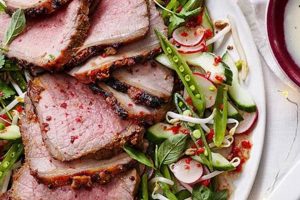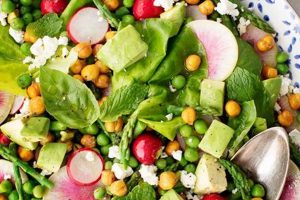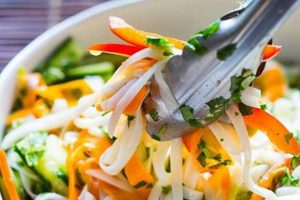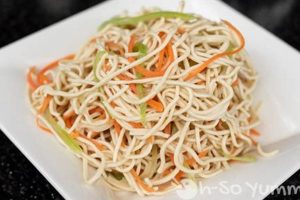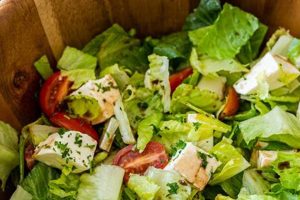Dishes utilizing jellied or whole berry cranberry sauce as a foundational ingredient offer a convenient and often festive approach to salads. These preparations frequently incorporate additional components such as fruits (pineapple, oranges, apples), nuts (pecans, walnuts), and sometimes vegetables (celery, jicama) to create a sweet, tart, and texturally diverse culinary experience. A classic example includes a combination of jellied cranberry sauce, crushed pineapple, and chopped walnuts, often bound with a creamy element like whipped cream or mayonnaise.
Such dishes represent a time-saving option, particularly during holidays or gatherings, due to the readily available nature of the primary ingredient. Their sweet and tart flavor profile complements a wide range of main courses, from roast turkey to grilled ham, making them a versatile side dish. Historically, these salads gained popularity in the mid-20th century with the rise of convenience foods and have become a staple in many holiday traditions.
This article will delve further into variations on these salads, explore their adaptability to diverse dietary needs and preferences, and offer practical tips for preparation and presentation.
Tips for Cranberry Sauce-Based Salads
Optimizing flavor and presentation requires attention to detail. The following suggestions offer guidance for creating successful and enjoyable cranberry sauce-based salads.
Tip 1: Balance Sweetness and Tartness: The inherent sweetness of canned cranberry sauce can be balanced with tart ingredients. Consider incorporating chopped Granny Smith apples, citrus segments, or a splash of lemon juice to achieve a well-rounded flavor profile.
Tip 2: Enhance Texture: Introduce textural contrast through the addition of chopped nuts (pecans, walnuts, almonds), dried fruits (cranberries, raisins), or toasted coconut flakes. These elements provide a pleasing counterpoint to the smooth consistency of the cranberry sauce.
Tip 3: Consider the Binding Agent: Traditional recipes often utilize whipped cream or mayonnaise. Greek yogurt or a combination of yogurt and whipped cream can offer a lighter, tangier alternative.
Tip 4: Fresh Ingredients Elevate Flavor: Incorporating fresh ingredients like diced celery, chopped cilantro, or grated orange zest adds brightness and complexity to the overall flavor profile.
Tip 5: Chill Thoroughly: Allowing the salad to chill for at least two hours before serving allows the flavors to meld and enhances the textural experience.
Tip 6: Presentation Matters: Serve the salad in an attractive bowl or individual serving dishes. Garnish with fresh mint sprigs, candied cranberries, or a sprinkle of chopped nuts for visual appeal.
Tip 7: Adapt to Dietary Needs: Substitutions can easily be made to accommodate dietary restrictions. Use vegan whipped topping or a plant-based yogurt for dairy-free versions. Maple syrup or agave nectar can replace refined sugar.
By following these suggestions, one can elevate a simple cranberry sauce-based salad from a convenient side dish to a memorable culinary creation. Attention to flavor balance, texture, and presentation ensures a satisfying experience.
These tips provide a foundation for culinary exploration and adaptation. The following section will offer specific recipe examples to further inspire culinary creativity.
1. Ingredients
Ingredient selection significantly impacts the final character of cranberry sauce-based salads. Canned cranberry sauce, the foundational component, provides the characteristic sweet-tart flavor profile. Variations exist within this category, ranging from whole berry to jellied sauce, each contributing distinct textural and visual elements. Beyond the cranberry base, ingredients fall into several categories, each playing a specific role.
Fruits, such as pineapple, oranges, and apples, contribute sweetness, acidity, and textural complexity. Pineapple offers a tropical sweetness while oranges provide a citrusy brightness. Apples, particularly tart varieties like Granny Smith, balance the sweetness of the cranberry sauce. Nuts, including pecans, walnuts, and almonds, add crunch and richness. Their inherent fats complement the fruit components while offering a textural counterpoint. Binding agents, typically whipped cream, mayonnaise, or yogurt, create cohesion and contribute to the overall creaminess of the salad. These ingredients, along with optional additions like celery, marshmallows, or spices, work synergistically to define the salad’s final flavor and texture. For example, a salad featuring whole berry cranberry sauce, chopped pecans, and diced oranges offers a brighter, more texturally diverse experience compared to a salad made solely with jellied cranberry sauce and crushed pineapple.
Understanding the role of each ingredient allows for informed choices based on desired flavor profiles and dietary needs. This knowledge enables adaptation and customization, transforming a simple recipe into a personalized culinary creation. Careful ingredient selection is paramount to crafting a balanced and flavorful salad. Whether adhering to traditional combinations or exploring innovative additions, understanding the interplay of ingredients is crucial for achieving desired outcomes.
2. Texture
Texture plays a crucial role in the overall enjoyment of cranberry sauce-based salads. The inherent smoothness of canned cranberry sauce, particularly the jellied variety, establishes a foundational texture that can be either complemented or contrasted through the addition of other ingredients. Consideration of textural diversity elevates these salads from simple to complex culinary experiences. A salad comprised solely of jellied cranberry sauce and whipped cream offers a uniformly smooth texture, while the incorporation of chopped nuts, such as pecans or walnuts, introduces a contrasting crunch. Similarly, the addition of diced apples or pineapple provides a slightly firmer texture, further enhancing the sensory experience.
The interplay of textures creates a more dynamic and engaging consumption experience. A salad featuring a variety of textural elementssmooth, crunchy, and slightly firmoffers a more stimulating and satisfying experience than one with a single, uniform texture. For example, a salad combining whole berry cranberry sauce, chopped pecans, and diced celery offers a complex textural profile, appealing to a broader range of palates. Conversely, a salad made exclusively with jellied cranberry sauce and marshmallows might be perceived as overly smooth and lacking textural depth. Achieving textural balance contributes significantly to a salad’s overall appeal.
Understanding the importance of texture in these salads allows for intentional ingredient selection and preparation techniques. Dicing ingredients finely versus coarsely, or opting for whole versus crushed nuts, directly influences the final textural outcome. This understanding empowers culinary control, enabling the creation of salads tailored to specific preferences. Ultimately, a well-balanced textural profile significantly contributes to the enjoyment and satisfaction derived from cranberry sauce-based salads.
3. Flavor Profiles
Flavor profiles in cranberry sauce-based salads hinge on the inherent sweet-tart character of the foundational ingredient. This characteristic flavor establishes a base upon which other ingredients build, creating a balanced and complex profile. The interplay of sweet, tart, savory, and sometimes spicy elements determines the overall gustatory experience. For instance, the traditional pairing of jellied cranberry sauce with pineapple accentuates sweetness, while the addition of chopped walnuts introduces a subtle nuttiness that complements, rather than overwhelms, the core flavors. The perceived sweetness of canned cranberry sauce often necessitates balancing elements. Tart apples, such as Granny Smith, or a squeeze of fresh lemon juice, provide acidity to counterbalance the sweetness, preventing an overly saccharine result.
Strategic ingredient selection allows for customization of flavor profiles. Incorporating orange segments introduces a citrusy brightness, while the addition of fresh mint provides a refreshing herbal note. Spices, such as cinnamon or ginger, can add warmth and complexity, particularly suited for autumnal or winter variations. These additions broaden the potential flavor spectrum, moving beyond the basic sweet-tart foundation to create more nuanced and personalized culinary experiences. A salad featuring whole berry cranberry sauce, pecans, and diced oranges offers a distinctly different flavor profile compared to one made with jellied cranberry sauce, pineapple, and marshmallows. Understanding these flavor dynamics empowers culinary creativity.
Successful cranberry sauce-based salads achieve a harmonious balance of flavors. Overreliance on sweetness can result in a cloying dish, while an excess of tartness can be unpleasantly sharp. The goal is to create a layered and balanced flavor profile that engages the palate without being overwhelming. This understanding of flavor interplay allows for informed ingredient selection and measured incorporation, resulting in a more satisfying and enjoyable culinary outcome. Careful consideration of flavor profiles ensures that each ingredient contributes positively to the overall taste experience, transforming a simple side dish into a nuanced culinary creation.
4. Preparation Methods
Preparation methods significantly influence the final quality and character of cranberry sauce-based salads. While the inherent convenience of canned cranberry sauce simplifies the process, several key steps contribute to optimal results. The choice between whole berry and jellied cranberry sauce impacts both texture and visual appeal. Whole berry sauce offers a more rustic appearance and a distinct textural element, whereas jellied cranberry sauce creates a smoother, more homogenous texture. Furthermore, the method of incorporating additional ingredients affects the final presentation and flavor distribution. Gently folding ingredients together preserves their individual characteristics, while more vigorous mixing can result in a more uniform, albeit less visually distinct, salad.
Ingredient preparation also plays a crucial role. Chopping nuts coarsely versus finely alters texture, while dicing fruits into uniform pieces ensures even distribution of flavor and enhances visual appeal. The binding agent, whether whipped cream, mayonnaise, or yogurt, requires careful incorporation to achieve the desired consistency and prevent the salad from becoming overly dense or watery. For example, whipped cream should be folded in gently to maintain its airy texture, while mayonnaise should be thoroughly blended to ensure even distribution. Chilling the salad for a period before serving allows flavors to meld and enhances the overall experience. This crucial step allows the diverse components to harmonize, creating a more cohesive flavor profile.
Mastery of preparation methods ensures consistent and desirable outcomes. Attention to detail, from the initial selection of cranberry sauce to the final chilling period, elevates the final product. Understanding the impact of each step, from ingredient preparation to mixing techniques, empowers informed choices and contributes to a more satisfying culinary result. Careful consideration of these methods transforms a simple assembly process into a deliberate culinary endeavor, ultimately resulting in a more enjoyable and aesthetically pleasing salad.
5. Presentation
Presentation significantly elevates cranberry sauce-based salads from simple side dishes to visually appealing culinary creations. Consideration of visual elements enhances the dining experience, transforming a basic dish into a more enticing and memorable offering. Strategic presentation techniques amplify the inherent appeal of these salads, encouraging enjoyment and appreciation.
- Serving Vessels
The choice of serving dish impacts the overall presentation. A clear glass bowl showcases the vibrant colors and textures of the salad, while a rustic serving platter creates a more informal aesthetic. Individual portions in small dishes or glasses offer a touch of elegance, particularly suitable for special occasions. Serving the salad on lettuce cups adds a fresh element and enhances visual appeal. The serving vessel should complement the salad’s composition and the overall dining setting.
- Garnishes
Garnishes provide a finishing touch, enhancing visual appeal and adding subtle flavor nuances. Fresh mint sprigs offer a pop of color and a refreshing aroma, while candied cranberries or orange zest provide a complementary flavor and textural accent. A sprinkle of chopped nuts or toasted coconut flakes adds visual interest and reinforces existing flavors within the salad. Garnishes should be chosen thoughtfully, complementing the salad’s existing components without overpowering the overall presentation.
- Color and Contrast
The vibrant red of cranberry sauce offers a strong visual foundation. Incorporating ingredients with contrasting colors, such as green grapes, orange segments, or chopped celery, creates visual interest and enhances the salad’s appeal. Consideration of color balance prevents a monotonous appearance and contributes to a more dynamic presentation. A monochromatic salad, while potentially elegant, can lack the vibrancy and visual excitement offered by a dish featuring complementary colors.
- Plating Techniques
Thoughtful plating elevates the presentation. Mounding the salad slightly in the center of the serving dish creates visual height and draws the eye. Creating layers of different ingredients, such as a base of lettuce topped with the cranberry salad and garnished with nuts, adds visual depth and complexity. For individual portions, consider using a small scoop or mold to create uniform and aesthetically pleasing shapes. Attention to plating details transforms a simple scoop of salad into a more refined and visually appealing presentation.
These presentation elements work synergistically to enhance the overall dining experience. A thoughtfully plated cranberry sauce-based salad, served in an attractive vessel and garnished appropriately, becomes more than just a side dish; it transforms into a visually appealing and memorable component of the meal. Attention to these details elevates the perceived value of the dish, demonstrating care and consideration for those partaking in the culinary experience. By understanding the impact of visual presentation, one can transform a simple cranberry sauce-based salad into a truly delightful culinary creation.
6. Dietary Adaptations
Dietary adaptations play a crucial role in ensuring cranberry sauce-based salads can be enjoyed by individuals with diverse nutritional needs and preferences. Modifying recipes to accommodate these needs expands accessibility without sacrificing flavor or satisfaction. Understanding common dietary restrictions and implementing appropriate substitutions allows for broader culinary inclusion.
- Sugar Considerations
Many canned cranberry sauces contain added sugar. For individuals managing blood sugar levels or following low-sugar diets, sugar-free or reduced-sugar cranberry sauce options are available. Alternatively, incorporating fresh cranberries or reducing the overall amount of cranberry sauce used can minimize sugar content. Adjusting recipes to accommodate sugar restrictions allows individuals to enjoy these salads while adhering to dietary guidelines. For instance, using a sugar-free cranberry sauce in a classic recipe maintains the traditional flavor profile while reducing overall sugar intake.
- Vegan and Vegetarian Adaptations
Traditional cranberry sauce-based salads often include ingredients like gelatin (derived from animal products) and mayonnaise (containing eggs). Vegan and vegetarian adaptations require substituting these components. Agar-agar offers a plant-based alternative to gelatin, while vegan mayonnaise or cashew cream provide suitable replacements for traditional mayonnaise. These substitutions ensure individuals following plant-based diets can enjoy these salads without compromising their dietary principles. A vegan cranberry salad might incorporate agar-agar for setting and a cashew-based dressing for creaminess.
- Gluten-Free Considerations
While cranberry sauce itself is typically gluten-free, some recipes may incorporate gluten-containing ingredients, such as crackers or certain binding agents. Ensuring all components are certified gluten-free or substituting with gluten-free alternatives accommodates individuals with celiac disease or gluten sensitivities. For instance, using gluten-free crackers in a cranberry salad with a crunchy topping maintains textural appeal while adhering to dietary restrictions.
- Dairy-Free Options
Traditional recipes often utilize whipped cream or yogurt. For individuals with lactose intolerance or following dairy-free diets, plant-based alternatives, such as coconut whipped cream or almond yogurt, offer suitable replacements. These substitutions maintain the creamy texture and contribute to a balanced flavor profile while accommodating dietary needs. A dairy-free cranberry salad might incorporate coconut whipped cream and a dairy-free yogurt for a light and tangy element.
By understanding and addressing these dietary considerations, cranberry sauce-based salads transition from niche offerings to inclusive culinary options. Careful ingredient selection and thoughtful substitutions ensure these dishes remain accessible and enjoyable for a wider range of individuals, demonstrating that dietary restrictions need not limit culinary enjoyment. Adaptability and thoughtful preparation ensure that these salads remain a versatile and inclusive culinary choice.
Frequently Asked Questions
This section addresses common inquiries regarding the utilization of canned cranberry sauce in salad preparations.
Question 1: What type of canned cranberry sauce is best suited for salads?
Both whole berry and jellied cranberry sauces are suitable. Whole berry sauce offers a more rustic texture and appearance, while jellied cranberry sauce provides a smoother, more homogenous texture. The choice depends on individual preference and the desired final product.
Question 2: Can sugar content be modified in these salads?
Yes. Sugar content can be managed by using sugar-free or reduced-sugar canned cranberry sauce. Incorporating fresh cranberries or decreasing the overall amount of cranberry sauce used also reduces the total sugar content.
Question 3: How can these salads be adapted for vegan or vegetarian diets?
Substituting traditional mayonnaise with vegan mayonnaise or cashew cream and replacing gelatin with agar-agar creates vegan-friendly versions. Ensuring all other ingredients align with dietary restrictions is crucial.
Question 4: Are canned cranberry salads inherently gluten-free?
While cranberry sauce is typically gluten-free, other ingredients, such as added crackers or certain binding agents, may contain gluten. Careful selection of ingredients or using gluten-free alternatives ensures dietary compliance.
Question 5: What are suitable dairy-free alternatives for traditional binding agents?
Coconut whipped cream and almond or soy-based yogurts offer suitable dairy-free replacements for whipped cream and traditional yogurt while maintaining desired texture and flavor profiles.
Question 6: How long can these salads be stored?
Properly stored in an airtight container in the refrigerator, these salads typically last for 3-5 days. The freshness of additional ingredients influences overall shelf life.
Understanding these common inquiries facilitates informed decision-making regarding ingredient selection, preparation, and adaptation of cranberry sauce-based salads to diverse dietary needs and preferences.
The following section provides a collection of curated recipes to inspire culinary exploration and demonstrate the versatility of cranberry sauce-based salads.
Canned Cranberry Salad Recipes
Exploration of dishes centered around canned cranberry sauce reveals their versatility and adaptability. Examination of core componentsingredients, textures, flavor profiles, preparation methods, presentation, and dietary adaptationsdemonstrates the potential for culinary creativity within this seemingly simple dish category. From classic combinations to innovative variations, the utilization of canned cranberry sauce offers a foundation for diverse culinary expressions. Understanding the interplay of these elements empowers informed choices, transforming a convenient staple into a personalized culinary creation.
Canned cranberry sauce-based salads represent more than just a convenient side dish; they offer a canvas for culinary exploration. Their adaptability to diverse flavor profiles and dietary needs ensures broad appeal and continued relevance in contemporary cuisine. Further experimentation with ingredients, textures, and presentation promises to unlock even greater culinary potential within this adaptable dish category. This exploration encourages a renewed appreciation for the versatility and enduring appeal of canned cranberry sauce in the culinary landscape.

